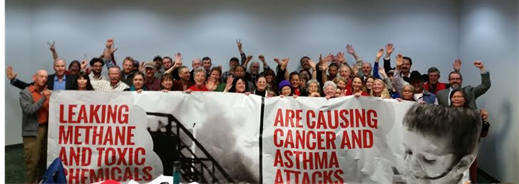Earlier this month, the Bureau of Land Management completed its mini-series of hearings on methane reduction and how the environmental and economic health of Americans would fare after the new rulings are implemented. The four recent hearings were held in Farmington, New Mexico; Oklahoma City, Oklahoma; Lakewood, Colorado; and Dickinson, North Dakota. Lena Moffit, director of the Sierra Club’s Stop Dirty Fuels campaign, reports that in all four locales, citizens – including over 150 Club activists -- speaking in favor of the BLM ruling greatly outnumbered those opposed.
Sally Jewell, U.S. Secretary of the Interior, announced a proposal on January 22 to reduce methane emissions in the form of wasted gas on both public and tribal lands. Her proposal outlines a limitation on venting, flaring and leaking from oil and gas operations in order to reduce waste and harmful emissions, with taxpaying citizens and tribes receiving a fair return. Additionally, the U.S. is the largest producer and contributor of natural gas and its emissions of methane and other greenhouse gases.
According to the official press release: “the proposed rule would require oil and gas producers to adopt currently available technologies, processes and equipment that would limit the rate of flaring at oil wells on public and tribal lands, and would require operators to periodically inspect their operations for leaks, and to replace outdated equipment that vents large quantities of gas into the air. Operators would also be required to limit venting from storage tanks and use best practices to limit gas losses when removing liquids from wells. The new measures would also clarify when operators owe royalties on flared gas, and ensure that BLM’s regulations provide congressionally authorized flexibility to set royalty rates at or above 12.5 percent of the value of production.”
Methane is reported to be about 25 times more potent a greenhouse gas than carbon dioxide, and without the new regulations set in place by both the Bureau of Land Management and the EPA, the emissions crisis would show no signs of stopping. In keeping with the Obama administration’s current plans to cut emissions from natural gas and oil by 40-45 percent from 2012 levels by 2025, the EPA in 2012 also issued the beginnings of VOC standards for the automotive industry. These stringent standards would reduce 190,000 to 290,000 tons of VOC and decrease methane emissions in an amount equivalent to 33 million tons of carbon pollution per year.
Despite efforts to combat the rampant emissions crisis, the Department of Interior found the BLM’s existing emissions requirements to be insufficient to combat this crisis. Colorado, North Dakota, Pennsylvania, Wyoming, and many other states have taken ambitious measures to mitigate emissions. The following article is the first in a four-part series that will profile the states involved in the hearings.
I. 2/16: Farmington, New Mexico
On February 16 at Juan College’s Henderson Fine Arts Center, the public meeting was held at the campus to deliberate on the methane leaks crisis plaguing the nation. The primary focus of the gathering was centered around the BLM’s push to update a 30-year-old ruling to enact stronger vigilance on methane emissions.
Amanda Leiter, BLM deputy assistant secretary for land and minerals management, revealed her stance on the performance of oil and gas producers to do a better job of capturing natural gas.
“Between 2009 and 2014, the emissions of methane from federal and Indian leases accounted for about 375 billion cubic feet of natural gas emissions, which would be enough to supply 5 million households in this country for a year,” Leiter said. “So that’s a waste. That’s not efficient operations. And the aim of the rule is to try to reduce that waste, to try to ensure that more of that natural gas is captured and sold and used in a productive way.”
Farmington mayor Tommy Roberts found irony in the proposed ruling as a result of the closure of marginal, low-producing wells that would have to be plugged because complying with the federal rule in its current form would immediately render many of those wells unprofitable.
Those in favor of the updated legislature cited the ill effects of methane pollution on air quality, as well as the number of jobs lost due to uncaptured gas. Camilla Feibelman, Director of the Sierra Club’s Rio Grande Chapter, likened the entire meeting to a “Kodak moment.”
“Don’t let profits divide and conquer us,” she said. “We have to remember the story of Kodak. Kodak, the grand company of photography, couldn’t get its head around the fact that times were changing, that people wanted digital cameras. And guess what? They went out of business. Workers need to be transitioned from fossil fuels-based industries to construction-, retrofitting- and renewable energy-based jobs.”
Feibelman said there already have been 2,000 jobs created in solar power this year and cited that example as a way to keep people working.
Those not in favor, such as Bloomfield mayor and San Juan County Commission Chairman Scott Eckstein, warned of job losses due to federal regulations and an economic downturn in crude oil prices. He and four other mayors published a letter to the BLM this past November vehemently opposing the ruling.
To say the nearly six-hour meeting was well-attended would be a gross understatement; over 600 people filled the college’s capacious performance hall, of whom 100 were scheduled to speak. Although the majority of attendants were in favor of the BLM ruling (58-26), a sizeable amount showed up in favor of the gas and oil industry. Moms, nurses, sportsmen, tribal leaders, vets, ranchers, faith leaders, and environmentalists were all present to show support for the BLM ruling during this crucial time for New Mexico’s environmental health.
